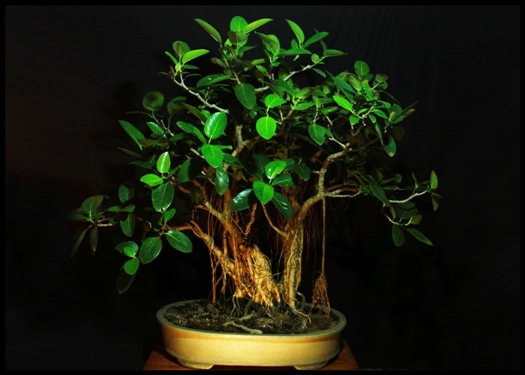Sunlight, temperature & humidity and their influence on bonsai in the tropics
It is generally known that almost all plant varieties need ambient light conditions and a certain amount of warmth & humidity for good growth. Climatic conditions are not the same throughout the world; they differ depending on the latitude in which the region is located. There are broadly two climatic zones in the world, viz., tropical (hot), temperate (very cold). Regions in the vicinity of the north or south poles are said to be in the temperate zone and experience extremely cold or near freezing climate almost throughout the year. Regions located around the Equator (tropical regions) have extremely hot climate throughout the year, hotter than all the other regions of the world due to the directness of the sun rays. Between these two extremes, are climatic conditions which vary from the cold to the hot to a greater or lesser extent, depending upon which latitude the region is located in. The nearer a region is to the north or south pole, i.e., between the Tropic of Cancer or Tropic of Capricorn and the respective pole and further away from the equator the more semi-temperate (more cold, less hot) the climate will be; conversely, the nearer a region is to the Equator, further away from either of the poles but between the Tropic of Cancer or Tropic of Capricorn and the equator, the more semi-tropical (more hot, less cold) its climate will be. Growing conditions are accordingly, significantly different in all these climatic zones, but sunlight, temperature and humidity play a very important role in the growth cycle of plants in general and bonsai in particular in the tropical belt and semi-tropical regions.
The scope of this article is confined to the consideration of the growing conditions in the tropical and semi-tropical belts, i.e., between the Tropics of Cancer and Capricorn, as this is the region I am most familiar with.
The tropical regions, both the tropical belt around the equator and the semi-tropical regions between the Tropic of Cancer or Tropic of Capricorn have four seasons: winter (January–February), summer (March–May), a monsoon (rainy) season (June–September) and a post-monsoon period (October–December).
In the tropical belt, i.e., between the Tropic of Cancer or Tropic of Capricorn, in the regions around the equator, the sun rays fall perpendicularly on the surface of the earth so that the intensity of sun-light is extremely high and average temperature varies from about 28 degrees Celsius to maximum 50 degrees Celsius. The length of the day is also very long, ranging from 9 hours a day in winter to around 12 hours a day in the height of summer. Rainfall in the tropical belt is perennial, i.e., it falls intermittently throughout the year due to accelerated evaporation caused by high temperatures,. This results in year-round growth of most of the plants due to higher humidity and consequently gives rise to some of the best tropical rain forests of the world. (there are temperate rain forests too). Bonsai too would have equally good growth due to the high humidity and temperature.
In semi-tropical (more hot, less cold) regions, the same conditions and seasons prevail except that the intensity of the sun is lesser than in the tropical belt due to the obliqueness of the sun rays falling on the surface of the earth. (The farther away from the equatorial region, the more oblique are the sun rays hitting the earth and consequently the lower the temperature). The length of daylight is also lessened comparatively. But otherwise the growing conditions for plants and bonsai are virtually the same. In most regions there is a prevalence of a season of heavy rainfall resulting in high atmospheric humidity followed by winter which is not very severe and summer in which it can get stiflingly dry & hot. The climatic conditions favor good growth of plants.
In both the cases there is a very short period of winter dormancy and also sun-light is available more-or less through-out the year. So, most of the varieties of plants which survive well in higher temperatures, tolerate higher sunlight conditions for long periods and do not require a dormant period can be grown easily and successfully as bonsai. Evergreen broad leaf varieties, deciduous broad leafs, succulents & arid region plants as also some coniferous evergreens which do not require a significant winter dormancy and require good sunlight & humidity do extremely well as bonsai in the tropics.
The second important factor is that root activity is faster in warmer soil temperatures compared to colder soil temperatures. It is for this reason that bonsai which are grown in temperate zones have only one annual growth cycle in spring due to its warmth, whereas there are three distinct warm periods in the tropics and consequently three definite periods for good root activity – the spring (about 2 months), the alternate showers & sunlight which provides humidity in monsoons (3 months) and the pre-winter heat (15 days-1 month); this means that the plants are also in high active growth during these three periods, apart from the regular growth due to the generally warm weather throughout the year.
Plant varieties which require high temperatures & humidity would naturally thrive very well in tropical climates. Due to the size of their leaves, broad leaf evergreen varieties are able to generate carbohydrates at a higher rate than the coniferous evergreens and therefore growth in broad leaf evergreens is observed throughout the year and regeneration is also speedier. Ficus especially are prone to form buttress roots and also profuse aerial roots. The availability of ambient sun light and humidity ensures that most of these varieties are successful as bonsai in tropical climates and can also be placed in full sun light throughout the year.
Nevertheless, others varieties which are basically temperate climate plants but require good sunlight also thrive as bonsai in these conditions due to the presence of high humidity. Conifers, especially many sub-varieties of junipers (e.g., L Juniperus Prostrata, Africans, etc.) which proverbially grow only once annually or at best in spurts in temperate zones and become dormant in the winter are observed to register noticeable growth even in the mild winters of the tropical climates due to good humidity and light conditions and will do well in the hot summers, provided those which are likely to scorch or get stressed in the severe mid-day sunlight in the height of summer are given some over-head protection. Some deciduous plant varieties (those which shed all their leaves almost at once in the autumn), basically of temperate origin (e.g., Chinese Elm, L Ulmus Parviflora) develop into evergreen / semi-evergreen plants if they are located for a long time or for a few generations in the tropical / semi-tropical regions. This is apparently the result of the heat and humidity.
A representative selection of typically tropical plant species are given below:
Excellent results are evident in the case of most Figs (L. Ficus species), Adenium (L. Adenium Obesum), Jade (L. Portulacaria Afra), Wax (L. Carmona Microphylla), Wrightia (L. Wrightia Religiosa), Jasmine Orange (L. Murraya Exotica), Casuriana (L. Casuriana Equisetifolia)and some other tropical varieties, including foliage, flowering and fruiting plants.
Figs (L. Ficus species), at least some varieties, may tolerate slightly low light conditions, but most do better in good direct sunlight. Growth in direct sunlight is always healthy, more compact with lesser inter-nodal distances and a denser and bushier growth. Humidity will encourage aerial roots which are a main feature and attraction of ficus bonsai.
Adenium (L. Adenium Obesum), which is basically an arid region plant, needs maximum sunlight but do not really need humidity. The hotter the climate, the better is the flowering on adeniums. They can survive less or infrequent watering also.
Jade (L. Portulacaria Afra) grows well is full sunlight but do not really need humidity. Requires well drained soil even if it is not placed in rainy conditions. Will tolerate less watering but leaves shrivel if starved of water for long periods. Thrives well in extreme sunlight provided it is given adequate watering
Wax (L. Carmona Microphylla) also needs good sunlight for tight compact foliage and good flowering but requires more watering and more frequently. Needs constant trimming.
Wrightia (L. Wrightia Religiosa) requires good sunlight for flowering, although in some climates, it tends to shed leaves if in cold weather. Leaves may turn a dull yellow en masse, in extreme sunlight.
Jasmine Orange (L. Murraya Exotica or Paniculata)also requires good sunlight for flowering. However extreme sunlight stresses the plant resulting in yellowing of leaves in summer.
Casuriana (L. Casuriana Equisetifolia) also thrives well in good sunlight but requires humidity. Occasional spraying with salty water has a beneficial effect on the plants as they are mainly seen to grow well along sea shores.
Due to year-round growth, almost all tropical plants & bonsai need to be fertilized accordingly. There is hardly any dormancy even in the case of deciduous trees so fertilization need not be stopped on that account as is the practice in temperate regions. Nitrogen is also needed in higher doses than is required for conifers and other temperate trees.
Possibility of growing tropical varieties indoors in temperate regions:
In the temperate zones, as natural temperatures are significantly lower than tropical regions, the hot and humid conditions of tropical zones will have to be simulated artificially, if tropical varieties of plants are to survive, let alone grow successfully. Hot house or green house with artificial indoor lighting and heat & humidity can be installed to re-create tropical conditions but they are expensive. But green houses are largely extensions of the main house and depending upon the number of trees and their sizes may need quite a bit of space and are worthwhile for growing medium to large size bonsai. Mame & shohin bonsai can also be grown indoors without the need for green houses if there is central heating in the house and will thrive well provided ambient light and temperature are maintained; if mame bonsai are grown more trees can be kept in lesser space. However, due to lesser intensity than natural light in the tropics, the duration of artificial lighting needs to be greater, approximately 12 – 16 hours if the trees are to remain healthy. Specialized halide lights are more suitable for green house conditions but they are expensive and may need periodic replacement with new lamps to maintain light intensity; halogen lamps are equally good for light intensity but heat up too much. Small trees can be grown indoors under florescent tube lights but the trees will have to be placed very near the light source. And the light fixtures may not look decorative too and have to be replaced periodically.
Frequency and potency of feeding fertilizers also needs to be on a reduced and lesser scale.
It is certainly possible to grow tropical subjects successfully under indoor light conditions in temperate zones, provided proper growing conditions are maintained and adequate precautions are taken.

